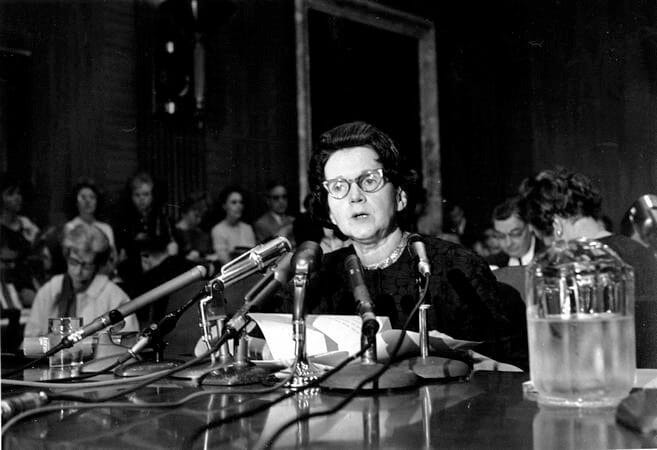By Anna Sikora:
Ecocriticism (environmental criticism) is not exactly new to the humanities, as it has been around for nearly a quarter of a century, but it is the latest to join the set of lenses – such as Marxism, Postcolonial theory and Feminism – through which students are invited to read literature. Do these theoretical frameworks enhance our understanding of literature and the creative process behind writing? Perhaps yes; perhaps no.
What sets ecocriticism apart is the figure of a woman, Rachel Carson, a writer and scientist who jump-started the emergence of environmental movements in the 1960s, and became an inspiration to the multitudes of writers and activists, as well as regular readers. Carson, unlike Karl Marx, Edward Said, and Judith Butler, did not create elaborate theories but wrote a nonfiction book: Silent Spring (1962). The short book talked about the dangers of insecticides, especially DDT, that contaminate water, air and soil, killing birds, fish, animals and entering our bodies, causing cell mutations. It is a fascinating exercise to piece together the initial reactions to both Carson and her book which, considered so significant today, received mixed opinions at the time of its publication.
According to the National Review, Silent Spring is one of the top 100 best non-fiction books of the twentieth century, alongside the work of George Orwell, C.S. Lewis, Pope John Paul II, Albert Einstein, Sigmund Freud, and others. In the 1960s, Carson was already featured amongst the most influential people of the decade, and in ‘Personalities of the Week: People and Events in the Public Eye’, a piece found in The Illustrated London News Historical Archive, she earns the title of the ‘Protector of Nature Against Chemicals.’ Here, Carson shares the spotlight with Geraldine Mock, the first woman to fly around the world solo, and Charles De Gaulle, the President of France, amongst others.

Gale Primary Sources offers access to many of the book’s reviews. One of which, entitled ‘Elixirs of Death’ and published in 1963 in The Times Literary Supplement is respectful of Carson and ends with the words ‘this controversial book, with its well-marshalled evidence, carries a message that none of us can afford to ignore.’

Another raving review, entitled ‘When the Sedge Withers And No Birds Sing’, appears in The Times in 1963 and here the author introduces the British edition of the book prefaced by Sir Julian Huxley and introduced by Lord Shackleton. The reviewer, however, complements Miss Carson and tells us that she needs no ‘sponsors’ as she is ‘a self-confident controversialist.’ The review talks about the book’s bumpy launch in the US in 1962 and reiterates the consensus of the British press that the powerful book is ‘eloquent, sincere – and alarming.’

‘Cassandra in the Cornfields’, a review published in The Economist in 1963, differs slightly from the reviews published by The Times. The article begins by asking if Carson’s book is merely propaganda aimed at damaging the reputation of chemical companies, which, after all, protect fields and crops from a variety of pests. Carson’s book, the article informs us, is written in ‘white-hot anger with words tumbling and stumbling all over the page (rare are the passages where Miss Carson shows her normal, elegant command of language).’ As the review progresses, however, its author finds Carson’s arguments irrefutable and admits the possibility of similar dangers in Britain. It concludes that Carson’s book may offend those who trust science, but concedes that we need people like her to question the not-always-so infallible scientific progress.

Interestingly, another article published in The Times in 1963 entitled ‘Danger In Misuse Of Pesticides’ reports that President Kennedy actually called a commission to look into Carson’s claims on the dangers of pesticides.

A year later, another article published in The Times, ‘More Stringent Tests On U. S. Pesticides’, describes how within only two years of the book’s publication, President Johnson was introducing legislation aimed at tightening controls over pesticide use.

In the meantime, concerns over pesticides had found their way into the House of Lords. An article published in The Times in 1963 described the debate on the necessity to regulate the use of chemicals in British agriculture, which included contributions from Lord Shackleton and Lord St. Oswald and included references to Rachel Carson’s book. The latter argued for the motion to be withdrawn from the house on the grounds that pesticides are not without benefits, and precautions were being taken. St. Oswald did not directly deny Carson’s scientific standing, but proclaimed the author to be ‘primarily a publicist with a motive.’ The motion was therefore withdrawn.

Rachel Carson died of cancer in 1964 at the age of 56.
Header image citation:
“Rachel Carson.” News Features & Internal Communications Image Collection, Primary Source Media, 1963. Associated Press Collections Online, http://tinyurl.galegroup.com/tinyurl/5gzZJ9
Activist and author Rachel Carson, whose book Silent Spring led to a study of pesticides, testifies before a Senate Government Operations Subcommittee in Washington, D.C. on June 4, 1963. Carson urged Congress to curb the sale of chemical pesticides and aerial spraying.
©AP Images – Appearing in this student-authored post under Fair dealing in United Kingdom – Research and Study.
Bibliography:
“Cassandra in the Cornfields.” Economist, 23 Feb. 1963, p. 711. The Economist Historical Archive, 1843-2011, tinyurl.galegroup.com/tinyurl/5ZP8M1 Accessed 26 Nov. 2017
“House Of Lords.” Times, 21 Mar. 1963, p. 6. The Times Digital Archive, tinyurl.galegroup.com/tinyurl/5ZP8d3
National Review. The Non-Fiction 100. www.nationalreview.com
OWN, OUR. “Danger In Misuse Of Pesticides.” Times, 16 May 1963, p. 11. The Times Digital Archive, tinyurl.galegroup.com/tinyurl/5ZP6s7
OWN, OUR. “More Stringent Tests On U. S. Pesticides.” Times, 13 May 1964, p. 14. The Times Digital Archive, tinyurl.galegroup.com/tinyurl/5ZP6d1
“Personalities of the Week: People and Events in the Public Eye.” Illustrated London News, 25 Apr. 1964, p. 657. The Illustrated London News Historical Archive, 1842-2003, tinyurl.galegroup.com/tinyurl/5ZP7S9
Rees,, William James,, and W. REES. “Elixirs of Death.” The Times Literary Supplement, 22 Feb. 1963, p. 129. Times Literary Supplement Historical Archive, tinyurl.galegroup.com/tinyurl/5ZP67X
Steiguer de J.E. The origins Of Modern Environmental Thought. Tuscon: The University of Arizona Press. 2006.
“When the Sedge Withers And No Birds Sing.” Times, 14 Feb. 1963, p. 15. The Times Digital Archive, tinyurl.galegroup.com/tinyurl/5ZP7c6


